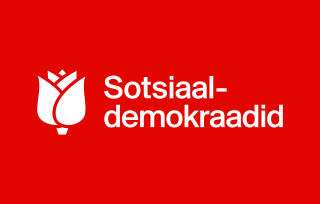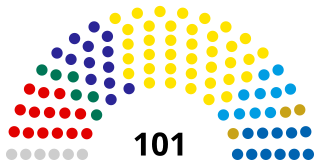
Otto August Strandman was an Estonian politician, who served as Prime Minister (1919) and State Elder of Estonia (1929–1931).

The Social Democratic Party is a centre-left political party in Estonia. It is currently led by Lauri Läänemets. The party was formerly known as the Moderate People's Party. The SDE has been a member of the Party of European Socialists since 16 May 2003 and was a member of the Socialist International from November 1990 to 2017. It is orientated towards the principles of social-democracy, and it supports Estonia's membership in the European Union. From April 2023, the party has been a junior coalition partner in the third Kallas government.

The Riigikogu is the unicameral parliament of Estonia. In addition to approving legislation, the Parliament appoints high officials, including the prime minister and chief justice of the Supreme Court, and elects the president. Among its other tasks, the Riigikogu also ratifies significant foreign treaties that impose military and proprietary obligations and bring about changes in law, as well as approves the budget presented by the government as law, and monitors the executive power.

Jaan Tõnisson was an Estonian statesman, serving as the Prime Minister of Estonia twice during 1919 to 1920, as State Elder from 1927 to 1928 and in 1933, and as Foreign Minister of Estonia from 1931 to 1932.
The State Elder, sometimes also translated as Head of State, was the official title of the Estonian head of state from 1920 to 1937. He combined some of the functions held by a president and prime minister in most other democracies.
Parliamentary elections were held in Estonia on 24 and 25 February 1938. The National Front for the Implementation of the Constitution won 64 of the 80 seats. In turn, the Front was essentially an enlarged version of the pro-government Patriotic League.
Constituent Assembly elections were held in Estonia on 5–7 April 1919. The elections were called by the Estonian Provisional Government during the Estonian War of Independence. The Assembly was elected by party-list proportional representation in one nationwide district using the D'Hondt method. Eligible voters included soldiers at the front. The elections were won by left-wing and centrist parties.
The Estonian Labour Party was a political party in Estonia. It was formed in 1919 by a merger of the Radical Socialist Party and the Social Travaillist Party, and ceased to exist in 1932, when it merged with other centrist parties to form the National Centre Party. It was a member of government coalitions between 1919 and 1925, and again from 1927 until 1931.
The Estonian People's Party was a centre-right political party in Estonia.
A referendum on restoring voluntary religious education to state schools was held in Estonia between 17 and 19 February 1923. It was approved by 71.9% of voters with a turnout of 66.2%.

The Farmers' Assemblies was a conservative political party in Estonia. Led by Konstantin Päts, it was one of the ruling parties during most of the interwar period.
The Estonian Independent Socialist Workers' Party was a political party in Estonia.
The Settlers' Party was a political party in Estonia.
The Landlords' Party, also known as the House Owners' Party, was a political party in Estonia.
The Demobilised Soldiers' Union was a political party in Estonia between 1921 and 1925.
The Estonian Socialist Workers' Party was a political party in Estonia.
The Union of Settlers and Smallholders was a political party in Estonia.
The National Centre Party was a political party in Estonia.
The Estonian Democratic Party was a political party in Estonia.
The Democratic Bloc was a political grouping in Estonia.





